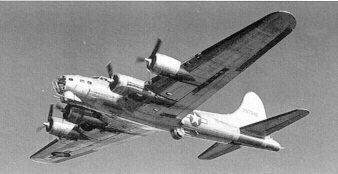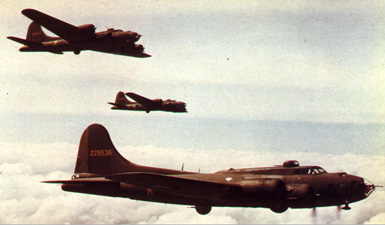Boeing B-17 Flying Fortress




Click HERE to see the 3-way view; use your BACK button to return.
SYNOPSIS: One of the most well-known bombers of all time, the B-17 Flying Fortress became famous in the long daylight bombing raids over Europe in WWII. While it lacked the range and bombload of its contemporary the B-24 Liberator, the B-17 became the more famous of the two due to the many tales of B-17s bringing their crews back home despite heavy damage. With up to thirteen machine guns, the B-17 seemed to be a genuine flying "fortress in the sky". However, bomber losses reached the unacceptable point in 1943 in the face of stiff German opposition, and the B-17s had to wait until the introduction of long-range fighter escort before they could continue their war against the Reich. (Also, see the page on the YB-40, which was a heavily-armed B-17 meant to escort other B-17s.)
LONG HISTORY: for a more detailed history of this aircraft, click HERE.
SPECIAL NOTE: I have a separate website called BATTLE-DAMAGED B-17 FLYING FORTRESSES, which is a photo collection of B-17s that came home despite damage received in combat. Check it out!
For more data on this aircraft, click
here for Joe Baugher's
webpage.
USAF archives on this aircraft, click
here.
To see books about this aircraft on Amazon.com, click here.
Additional information on this aircraft
can be found at Wikipedia
here.
(updated February 2009)
Boeing B-17 Flying Fortress
Type: Heavy bomber
Crew: 10: Pilot, Co-Pilot, Engineer, Bombardier, Radioman, 5 Gunners
Armament: thirteen .50 cal machine guns (G model)
up to 17,600 lbs. of bombs
Specifications:
Length: 74' 4" (22.66 m)
Height: 19' 1" (5.82 m)
Wingspan: 103' 10" (31.65 m)
Gross Weight: 55000.0 lb
Propulsion:
No. of Engines: 4
Powerplant: Wright R-1820 Cyclone
Horsepower: 1200 hp each
Performance:
Range: 1850 miles w/ 4000 lb. bombload
Cruise Speed: 170 mph (273 km/h)
Max Speed: 300 mph (483 km/h)
Ceiling: 35000 ft (10667 m)
CLICK HERE TO SEE BOOKS ON THE B-17 ON AMAZON.COM
If this page does not have a navigational frame on the left, click HERE to see the rest of the website.